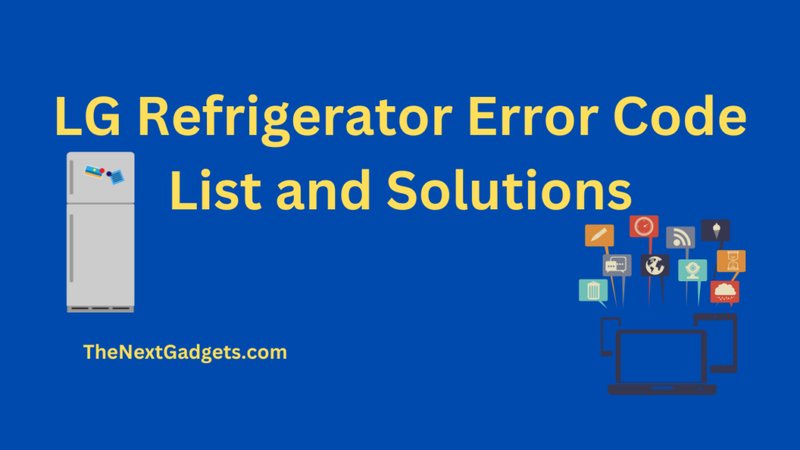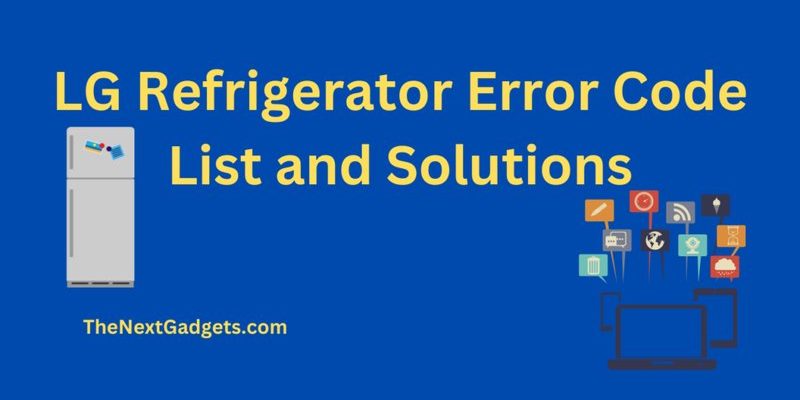
In simple terms, the “LE” error code on an LG refrigerator is a signal that something isn’t quite right. It’s like your fridge is raising a little red flag to get your attention, letting you know there might be an issue with the motor or the sensor responsible for keeping everything running smoothly. But just like a hiccup in your daily routine, it doesn’t necessarily spell disaster. Let’s dive a little deeper into what this error means and what you can do about it.
Understanding the “LE” Error Code in LG Refrigerators
When your LG refrigerator flashes the “LE” error code, it’s basically saying, “Hey, I’ve got a problem here!” But don’t worry too much just yet. This code is usually related to the motor responsible for making the fridge’s cooling mechanism tick. Think of it like the engine in a car. If something’s off with the engine, the car might not run as smoothly, or in this case, the fridge might not cool as efficiently.
The “LE” error can stem from a variety of issues. It could be as simple as a loose wire or as complex as a motor that’s struggling due to wear and tear. Imagine how a loose shoelace might trip you up while running. Similarly, a small issue with the motor can cause the fridge to misbehave slightly. However, it doesn’t mean you need to panic or stop using your fridge altogether. In many instances, the fridge might still function, albeit not at peak efficiency.
Before jumping to conclusions, it’s a wise idea to do a quick check. Look for any visible signs of trouble, like strange noises or a motor struggling to start. Often, these signs can give you valuable clues about whether a simple fix might do the trick or if it’s time to call in the pros.
Common Causes of the “LE” Error Code
Let’s explore some of the usual suspects behind the “LE” error code. One common culprit is the motor’s electrical connection. Over time, wires can become loose or frayed, much like a worn-out shoelace. This might lead to intermittent problems, causing the error code to pop up. Another possibility is that the motor itself is having trouble. Motors, like any other machine, have a lifespan and might eventually need repairs or replacements.
Sometimes, the issue might be related to sensors that work alongside the motor. These sensors help monitor the internal workings of the fridge, ensuring everything runs smoothly. If a sensor fails, it could falsely report an issue, triggering the “LE” code even when the motor is fine. Imagine a smoke detector mistakenly going off when there’s no smoke – frustrating, right? The same logic applies here.
Another potential cause could be the motherboard. This integral component can malfunction, sending incorrect signals throughout the fridge, much like a faulty conductor leading an orchestra astray. If this happens, the “LE” code might appear without any real motor issues. In any of these cases, it’s crucial to determine the exact cause to decide the best course of action.
Steps to Take If You See the “LE” Error Code
So, what should you do when faced with the “LE” error code? First off, don’t panic. Most times, the fridge will continue to work, just not as efficiently as it should. A good first step is to unplug the fridge for a few minutes and then plug it back in. It’s akin to giving your smartphone a quick restart when it starts acting up.
If a quick reset doesn’t clear the error, inspect the motor and its wires for any visible wear or damage. Sometimes, a visual inspection can reveal simple fixes like reattaching a loose wire. If the issue persists, however, it might be time to contact a professional. These certified technicians have the right tools and know-how to tackle more complex problems and can get your fridge running smoothly again.
And here’s a pro tip—regular maintenance can prevent issues like these. Much like you’d service a car, giving your fridge a little TLC now and then can keep it in top-notch condition and ward off error codes.
Is It Safe to Continue Using the Fridge?
You might be wondering, “Can I keep using my fridge even with this error?” The short answer is, in most cases, yes. As long as your fridge is still cooling effectively and there’s no additional sign of malfunction, it should be fine for short-term use. However, prolonged neglect might worsen the issue, potentially leading to more costly repairs down the road.
Think of it this way: driving a car with a blinking check engine light might be okay for a short trip, but you wouldn’t want to do a cross-country drive without addressing the underlying problem. Similarly, it’s wise to monitor the fridge’s performance carefully and seek professional help if the error persists.
To keep things running smoothly, consider setting up a routine maintenance check. Scheduling an annual or bi-annual service can help catch any minor issues before they escalate, saving you both time and money.
Preventing Future Error Codes
Let’s face it, dealing with error codes isn’t anyone’s idea of fun. Luckily, there are steps you can take to minimize the chances of seeing that pesky “LE” code again. Regular cleaning and maintenance are your best allies. Dust and debris can accumulate over time, causing parts to function less efficiently, much like how a clogged drain can slow down water flow.
Make a habit of checking cables and connections occasionally to ensure everything is snug and secure. This simple practice can prevent loose connections that often trigger errors. It’s like tightening the screws on a wobbly chair to keep it stable.
Finally, keep an eye on how your fridge is running. Listen for any unusual noises and observe any changes in temperature. By staying alert to these signals, you can catch potential problems early, ensuring your fridge remains a reliable workhorse in your kitchen.
Here’s to keeping your kitchen appliances in great shape and avoiding those pesky error codes!
